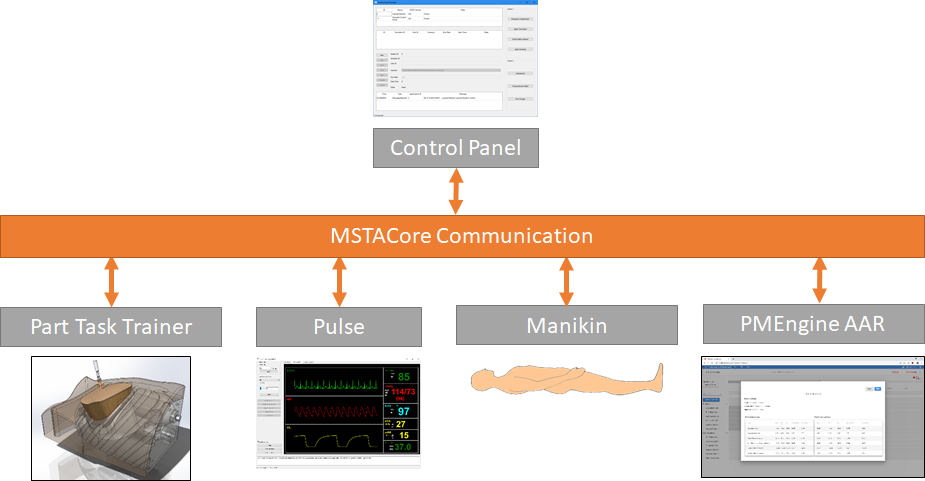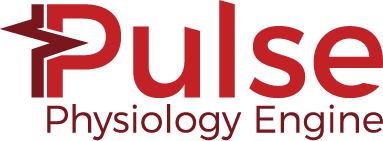Kitware provides Pulse Physiology Engine Support to SimQuest for the Medical Simulation and Training Architecture

Introduction
Medical Simulation Training Architecture (MSTA), sponsored by the Defense Health Agency (DHA) and Program Executive Office for Simulation, Training, and Instrumentation Joint Program Manager for Medical Modelling and Simulation (PEO STRI JPM MMS), is envisioned to be the overarching, end-to-end architecture that will enable interoperability across the holistic Medical Simulation Training System (MSTS) suite of simulation and training capabilities.
MSTACore is a standardized software platform to support interoperability between various medical and tactical simulation and training environments. This platform provides an open standard to connect manikins, part-tasks trainers, physiology engines, and other simulation technologies to support the creation of complex training systems necessary for future force readiness efforts.
The goal of MSTACore is to solve interoperability problems by:
1) Defining standards for interfaces that support and encourage reuse, interoperability, composability, and integration of software and hardware components.
2) Defining data standards between medical simulators, as well as between patient case data created in a non-medical framework for use by medical simulators.
3) Creating a common infrastructure that supports measurement of performance and assessment of learning across medical simulations.

The Company: SimQuest
Using the latest advances in simulation, SimQuest’s medical training solutions replicate actual surgical tools and forces, giving users the opportunity to learn, practice, and measure their proficiency using state-of-the-art medical devices and procedures—without risk to patients.
Need: Why SimQuest Chose Pulse
The team, led by SimQuest, wants to ensure the architecture can support complex scenarios by developing a basic training scenario to demonstrate 3rd party components using MSTA. SimQuest wanted to integrate a physiology engine to add dynamic physiologic feedback to their demonstration scenario. SimQuest approached Kitware for support to encapsulate Pulse for inclusion in MSTA.

Pulse is an open source physiology engine with a public repository for community use, advancement, and collaboration in human physiology simulation research. Pulse provides the numerical models that represent the human physiology. Pulse can dynamically change the physiology of its virtual patient through various procedures and provides observable data that can be used to drive medical simulations, including hardware based patient simulators.
Solution:
MSTACore strives to enable network communication between the various components of medical simulation. It enables data and architectural interoperability by providing both data specifications and the software libraries needed for components to share a consistent abstraction of reality. The Pulse Physiology Engine Platform includes the numerical models that represent the human physiology, a common data model (CDM) and a software interface. This framework matches the goals of the program and will help drive the design decisions needed to achieve the architectures’ goals.
The Pulse CDM provides a description of the data and relationships needed to model simulate human physiology. On top of that MSTACore provides an ontology between all necessary medical simulation data, at various levels of representation, using the SNOMED-CT standard. By adding the data modeling expertise used in Pulse to the team, an extensible representation of medical simulation data is defined within the architecture, allowing for it to support increasingly complex simulations.
Pulse also defines a generic interface for interacting with its virtual patient. The simulated patient lies at the center of the ecosystem and may be linked to devices, including manikins, sensors, and other equipment. By combining the generic Pulse patient interface with the network standards defined in MSTACore, any virtual patient library can be integrated to communicate with other compatible components.
The results, including Pulse integration, were successfully showcased at a live demonstration at the end of June. The demonstration system combined a Laerdal Manikin, a custom control panel, a part task trainer, the Pulse Physiology Engine and the PMEngine Software by Aptima in an integrated scenario that took the virtual patient from field care through to role 2 care. MSTACore enabled these heterogeneous components to communicate and interoperate with each other.

Summary
This ongoing project shows how Kitware supports companies to enhance and advance medical simulation. The team hopes to continue to advance MSTACore. To learn more about how Kitware’s collaborative work, please read the “Kitware Customer Highlight” series. To learn more about the Pulse Physiology Engine and how we can help you build a custom application, please visit the Pulse site or contact us at kitware@kitware.com.
Disclaimer
This work was supported by the Program Executive Office for Simulation Training, Research, and Instrumentation (PEO-STRI) and the Joint Program Manager for Medical Modeling and Simulation (JPM-MMS) under Contract No. W900KK-17-C-0041 to SimQuest, LLC. The views, opinions and/or findings contained in this report are those of the authors and should not be construed as an official Department of Defense position, policy or decision unless so designated by other documentation.